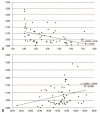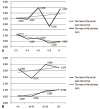Total Hip Arthroplasty Using Metal Head on a Highly Cross-linked Polyethylene Liner
- PMID: 27536629
- PMCID: PMC4972792
- DOI: 10.5371/hp.2015.27.4.216
Total Hip Arthroplasty Using Metal Head on a Highly Cross-linked Polyethylene Liner
Abstract
Purpose: This retrospective study was performed to evaluate the clinical results and measure polyethylene liner wear in total hip arthroplasty (THA) with highly cross-linked polyethylene.
Materials and methods: Except for patients who had died or were unable to have follow-up at least 2 years, 60 of 78 hips that underwent THA were included this study. The mean age was 64.5 years (range, 25-81 years) and the mean body mass index (BMI) was 23.0 kg/m(2) (18.1-32.3 kg/m(2)). Diagnosis at the time of the operation was osteonecrois of the femoral head in 28 hips, primary osteoarthritis in 14, hip fracture in 13, and other diseases in 5. The mean follow-up period was 3.8 years (2.1-7.1 years). Harris hip score (HHS) was reviewed before THA and at the last follow-up. On the anteroposterior pelvic radiographs, acetabular cup inclination and ante-version were also measured. The annual linear wear rate was measured using Livermore's method on the radiographs.
Results: The mean HHS was 60.1 (28-94) before operation and 90.4 (47-100) at the last follow-up. In the immediate post-operation, the average inclination and anteversion angles of the acetabular cups were 46.3° (standard deviation, ±6.7°) and, 21.4°(±10.1°) respectively. The mean of the annual linear polyethylene wear was 0.079 mm/year (0.001-0.291 mm/year). Age, gender and BMI were not statistically related to linear polyethylene wear but the period of follow-up and the acetabular cup's inclination showed significant negative and positive correlation respectively.
Conclusion: The wear rate of a highly cross-linked polyethylene was shown to correlate negatively with duration of follow-up. However, our study was based on a short-term follow-up, so a long-term follow-up study is necessary in the future.
Keywords: Highly cross-linked polyethylene; Linear wear rate; Total hip arthroplasty.
Figures


Similar articles
-
Correlation of Cup Inclination Angle with Liner Wear for Metal-on-polyethylene in Hip Primary Arthroplasty.Orthop Surg. 2017 May;9(2):186-190. doi: 10.1111/os.12337. Epub 2017 May 30. Orthop Surg. 2017. PMID: 28557297 Free PMC article.
-
[Comparative study on association between femoral head size and linear wear rate of highly cross-linked polyethylene liner].Zhongguo Xiu Fu Chong Jian Wai Ke Za Zhi. 2014 Nov;28(11):1333-7. Zhongguo Xiu Fu Chong Jian Wai Ke Za Zhi. 2014. PMID: 25639045 Chinese.
-
Results of Primary Total Hip Arthroplasty with 36-mm Femoral Heads on Highly Cross-linked Polyethylene-Minimum Seven-years Follow-up.Hip Pelvis. 2014 Dec;26(4):220-6. doi: 10.5371/hp.2014.26.4.220. Epub 2014 Dec 31. Hip Pelvis. 2014. PMID: 27536585 Free PMC article.
-
Highly crosslinked polyethylene wear rates and acetabular component orientation: a minimum ten-year follow-up.Bone Joint J. 2018 Jul;100-B(7):891-897. doi: 10.1302/0301-620X.100B7.BJJ-2017-1457.R3. Bone Joint J. 2018. PMID: 29954202
-
Risk factors for liner wear and head migration in total hip arthroplasty: a systematic review.Sci Rep. 2023 Sep 20;13(1):15612. doi: 10.1038/s41598-023-42809-4. Sci Rep. 2023. PMID: 37730762 Free PMC article.
Cited by
-
Metal-on-crosslinked polyethylene in total hip arthroplasty - an excellent combination at fifteen to twenty years of follow-up.Int Orthop. 2023 Oct;47(10):2547-2552. doi: 10.1007/s00264-023-05844-4. Epub 2023 May 29. Int Orthop. 2023. PMID: 37247019
References
-
- Laupacis A, Bourne R, Rorabeck C, et al. The effect of elective total hip replacement on health-related quality of life. J Bone Joint Surg Am. 1993;75:1619–1626. - PubMed
-
- Malchau H, Herberts P. Prognosis of total hip replacement. Int J Risk Saf Med. 1996;8:27–45. - PubMed
-
- Clohisy JC, Calvert G, Tull F, McDonald D, Maloney WJ. Reasons for revision hip surgery: a retrospective review. Clin Orthop Relat Res. 2004;(429):188–192. - PubMed
-
- Harris WH. Conquest of a worldwide human disease: particle-induced periprosthetic osteolysis. Clin Orthop Relat Res. 2004;(429):39–42. - PubMed
-
- Bauer TW. Particles and periimplant bone resorption. Clin Orthop Relat Res. 2002;(405):138–143. - PubMed
LinkOut - more resources
Full Text Sources
Other Literature Sources

